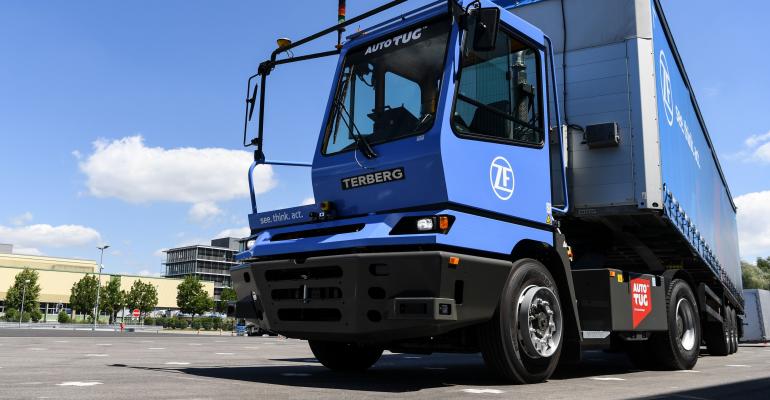FRIEDRICHSHAFEN, Germany – Their roots are in advanced passenger car-development, but the automation and electric-power systems put on display during ZF’s Technology Days this year all focus on commercial-vehicle applications.
And for good reason, according to CEO Wolf-Hennig Scheider – that’s where the automotive supplier expects to find its first customers for a broad range of automated driving controls and electric vehicle systems.
Scheider predicts 30% of all buses and vans and 20% of heavy-duty trucks will run on some form of electric power by 2025.
Regulations aimed at reducing oxides of nitrogen and growing social pressure to decrease diesel use will in part drive the rapid adoption, he says during a press briefing at company headquarters in Germany.
But commercial-vehicle users also will be motivated by lower total cost of ownership derived from lower fuel costs and faster return on investment as battery and component prices decrease with volume and technology advances.
Level 4 automated-driving technology, which still requires a driver be available to take over in an emergency, also will come more quickly to trucks and buses than passenger cars.
It’s easier to identify business cases among CV users that show significant productivity, safety and cost benefits, according to ZF.
Initial applications for such systems in CVs will come first to highly controlled environments such as freight yards, but will soon follow on controlled access highways, according to Scheider.
Urban roads pose far more complicated problems, but even there ZF sees opportunity for automation in specialized applications such as last-mile parcel delivery.
One of the foundational technologies displayed by ZF is a powerful processor that takes inputs from multiple video and radar sensors, fusing that information so it can be used to control a vehicle to react quickly and properly in widely varying situations.
Developed in partnership with graphics processor provider NVIDIA, ProAI still is about three years away from commercial availability for heavy vehicles, but it was the key technology in a number of demonstration vehicles rolled out by ZF for its press preview here.
A production model yard tractor, for example, was turned into a fully autonomous vehicle, dropping off a trailer to a specific location within a simulated freight yard and then maneuvering to pick up a second trailer, all without any driver aboard. It combined on-vehicle sensors feeding into a ProAI processor with various advanced vehicle controls to steer, brake and hook and unhook trailers.
An open platform telematics system relying on a ZF cloud service handled routing within the yard, and RFID chips embedded in the lot asphalt handled precision location even when the vehicle was shielded from GPS satellites by overhangs.
A second autonomous truck using similar advanced systems was able to swap containers, dropping off one and precisely maneuvering under another, again without any driver in the vehicle.
Anticipating rapid growth in demand for automated features, ZF also is focusing on developing components to extend automated CV controls.
The company already produces electrically controlled hydraulic steering systems needed for lane-keeping and other automated steering functions, but also rolled out an early prototype of a fully electric steering system with enough power to handle heavy-duty trucks.
Tentatively called the ReAX EPS, it will bring the company’s electric steering technology all the way up to Class 8 trucks. Currently such systems, which reduce weight and complexity while improving control, are restricted to light-duty trucks.
Moving down the logistics chain to last-mile delivery, ZF’s Innovation Van demonstrated how its sensors, controls and advanced processor could move a parcel delivery van though a route while its “driver” walked alongside dropping off packages.
The van could navigate around parked or stopped vehicles, move and park at the next delivery point, circle when parking was prohibited and even sequence loading for its operator by relying on the cloud-based telematics system.
Anticipating city restriction on internal-combustion engines, the van was fully electric-powered using an integrated transmission and electric motor ZF developed for passenger-car applications.
ZF’s electric power options for CVs all the way up to heavy-duty trucks included a wheel-end motor/gear reduction “portal” that was introduced late last year for bus applications and has already shown up on prototype medium- and heavy-duty trucks recently shown by a North American manufacturer.
It also had electric motor drives integrated with its heavy-duty automated mechanical transmission. With both bus and heavy truck demonstration units on hand for test drives, ZF says the technology is “almost ready for serial production.”
The company expects a full release of the automated hybrid transmission in both European and Asian markets in 2019.
Similar motor/transmission package for medium- and light-duty commercial applications were also on display, again developed from passenger-car systems reworked to handle CV operational conditions.
Both the CeTrax lite and CeTrax mid will round out the companies integrated CV electric drives when they reach the market later this year.





